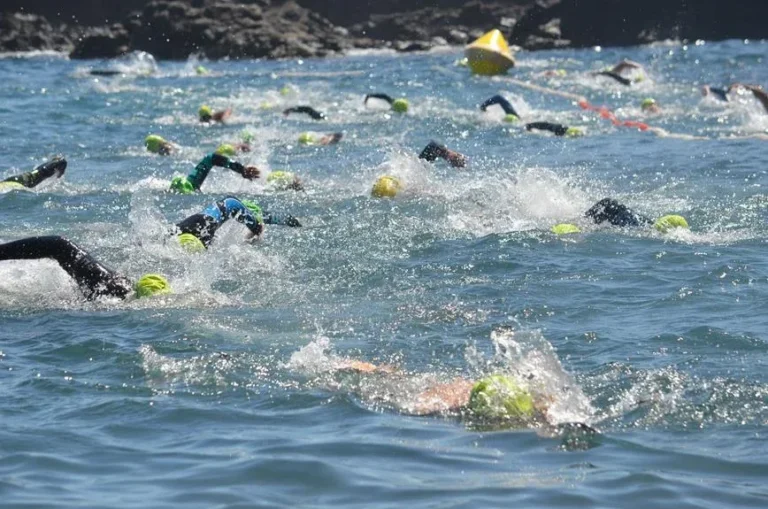Embarking on the waters of a triathlon is akin to navigating a vast sea of possibilities when it comes to determining what constitutes a good swim pace. The rhythm of your strokes, the efficiency of your breathing, and the precision of your turns all play a vital role in this aquatic pursuit.
But what truly defines a good triathlon swim pace? Dive deeper into the depths of this discussion to uncover the secrets that could propel you towards success in the water.
Key Takeaways
- Elite triathletes set pace benchmarks (under 1:20/100m women, 1:15/100m men)
- Aim for sub-40 min in age-group triathlons as a performance goal
- Top 10% Ironman swimmers maintain a pace around 1:35/100m
- Consistent training and goal setting crucial for achieving swim pace milestones
Factors Affecting Triathlon Swim Pace
Understanding the key factors that influence your triathlon swim pace is crucial for optimizing your performance in the water. Your swim pace isn’t solely dependent on your physical fitness level but also on various other aspects such as water conditions and skills. Factors like water temperature, currents, and visibility can impact your pace significantly. Additionally, honing your swimming skills, including proper technique, breathing control, and efficient stroke mechanics, can help you maintain a steady pace throughout the swim leg.
Your overall fitness level plays a vital role in determining your swim pace. Elite pro triathletes set the bar high with paces under 1:20/100m for women and under 1:15/100m for men. However, top 10% Ironman swimmers typically aim for an average pace of around 1:35/100m. It’s essential to set realistic swim pace goals based on benchmarks and performance targets to track your progress effectively and improve your overall triathlon performance.
Techniques for Improving Swim Speed
To enhance your swim speed, focus on refining your stroke technique, body position, and propulsion efficiency.
Improving your stroke technique involves maximizing the pull phase, ensuring a high elbow catch, and maintaining a strong kick for propulsion.
Body position plays a crucial role in reducing drag; aim to keep your body aligned and close to the water’s surface.
Incorporating interval training in your swim sessions can boost speed development by alternating between high-intensity bursts and recovery periods.
Using swim tools like paddles, fins, and snorkels can target specific areas for improvement, such as upper body strength or body alignment.
Additionally, working with a swim coach or joining a swim group can provide valuable feedback on your technique and help tailor training plans to enhance your speed and efficiency in the water.
Strategies for Consistent Swim Pace
Establishing a steady rhythm and stroke rate is key to maintaining a consistent swim pace for optimal efficiency and performance in triathlons. To achieve this, focus on proper breathing techniques and body alignment. Here are some strategies to help you maintain a steady swim pace:
- Consistent Stroke Rate: Keep a steady and controlled stroke rate throughout your swim to avoid burnout and maintain a consistent pace.
- Interval Training: Incorporate interval training into your swim sessions to improve pacing and endurance, helping you sustain a consistent speed.
- Monitoring Pace: Regularly monitor and adjust your pace during training to develop a reliable sense of your swim speed, enabling you to race more effectively.
- Body Alignment: Ensure your body is aligned correctly in the water to reduce drag and improve efficiency, contributing to a more consistent swim pace.
Setting and Achieving Swim Pace Goals
Maintain a strategic approach to your swim training by setting and pursuing specific swim pace goals to enhance your performance in triathlons. When setting goals, consider benchmarks like aiming for under 40 minutes in age-group triathlons.
To achieve these goals, focus on measurable targets such as breaking into the Top 10% in swim performance. Experience, skills, and pacing are vital in this process. Analyzing swim times objectively will help you set realistic and achievable swim pace goals for improvement.
Consistent training, addressing weaknesses, and seeking guidance are key factors in reaching your desired swim pace goals in triathlons. Remember, setting challenging yet attainable goals, backed by a structured training plan, will propel you towards success in improving your swim times and overall triathlon performance.
Stay committed to your objectives and celebrate each milestone achieved on your journey towards becoming a stronger swimmer in triathlons.
Comparing Swim Paces Across Distances
When comparing swim paces across different distances, it’s essential to consider the varying performance benchmarks set by elite triathletes and Ironman swimmers. To better understand the nuances of swim paces, it’s crucial to analyze elite performances and how they translate to different triathlon distances.
Here are some key points to keep in mind:
- Elite triathletes typically aim for swim paces under 1:20/100m for women and under 1:15/100m for men, showcasing exceptional speed and efficiency.
- In open water, expect a slightly slower pace of 5-20 seconds per 100m compared to pool swimming due to environmental factors and navigation challenges.
- Top 10% Ironman swimmers maintain an average pace of around 1:35/100m, highlighting a competitive swim pace achievable in long-distance events.
- Elite 10km swimmers can achieve remarkable speeds, finishing under 2 hours with a pace of 1:12/100m, emphasizing the importance of continuous improvement in your swimming abilities.
Conclusion
In conclusion, achieving a good triathlon swim pace requires a combination of factors such as training frequency, individual ability levels, and proper technique. By focusing on improving swim speed, maintaining consistency, and setting realistic goals, athletes can enhance their performance in the water.
It’s important to continually assess and adjust swim pace goals based on objective data to ensure progress and success in triathlon competitions. Keep pushing yourself and striving for improvement in your swim pace to reach your full potential.
